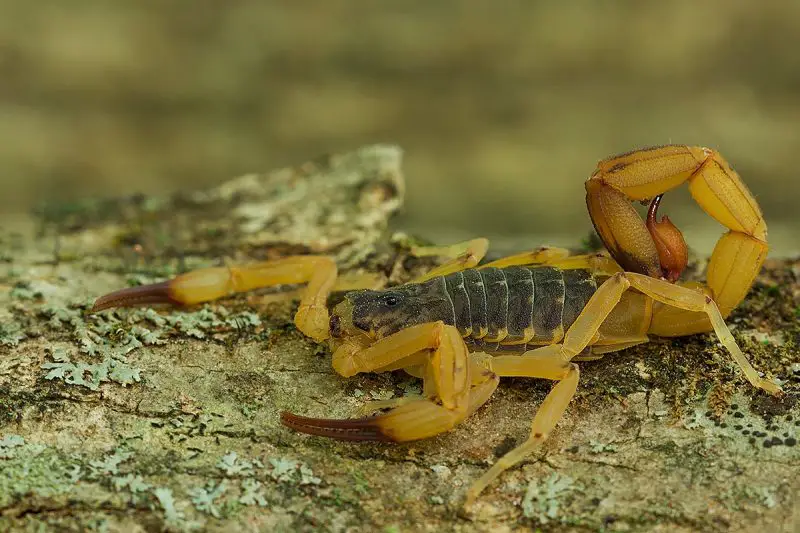South America is home to a wide array of venomous creatures, but none are quite as alarming—and fascinating—as Tityus serrulatus, the deadly Brazilian scorpion. Known for its potent venom, urban adaptability, and ability to reproduce without a mate, this species has become both a biological marvel and a public health concern.

What Is the Brazilian Yellow Scorpion?
With its pale, almost translucent yellow body and a tail that curves menacingly over its back, the Brazilian yellow scorpion (Tityus serrulatus) looks like something straight out of a nightmare—and for good reason. This medium-sized scorpion may not appear particularly fearsome at first glance, but beneath its delicate appearance lies one of South America’s most dangerous invertebrates.
Sleek, swift, and built for survival, Tityus serrulatus is instantly recognizable by its slender pincers and segmented tail ending in a venom-loaded stinger. When threatened or hunting, it arches its tail high and strikes with surgical precision—injecting neurotoxins that can cause everything from searing pain to life-threatening complications.
Scientific Snapshot
-
Family: Buthidae
-
Genus: Tityus
-
Species: Tityus serrulatus
-
Common Name: Brazilian Yellow Scorpion
Native to Brazil’s southeastern regions, this species has found a disturbing level of comfort in human environments. Cities like São Paulo, Belo Horizonte, and Rio de Janeiro have become hotspots, where this scorpion slinks through sewer systems, hides in household crevices, and emerges when least expected.
More than just a desert-dwelling predator, the Brazilian yellow scorpion is an urban survivor—one that thrives in the very heart of Brazil’s largest cities, with no signs of slowing down.
Why Is This Scorpion So Dangerous?
It’s not just the look that should make you cautious around Tityus serrulatus—it’s what you can’t see that makes this scorpion truly terrifying. Behind its sleek yellow armor lies a biochemical weapon capable of disrupting the human nervous system within minutes. And worse, it’s showing up right on people’s doorsteps.
A Venom Designed to Paralyze
The sting of the Brazilian yellow scorpion delivers more than just pain—it unleashes a neurotoxic storm. At the center of this chemical assault is Ts1, a powerful peptide that hijacks your body’s sodium channels, the very pathways that allow nerves to communicate. Once affected, your nervous system begins to misfire.
What happens next can be swift and brutal:
-
An explosion of searing pain at the sting site
-
Uncontrollable vomiting, sweating, and tremors
-
Spiking blood pressure as your body goes into panic mode
-
Breathing difficulties, sometimes severe enough to require hospitalization
-
In vulnerable individuals—especially young children and the elderly—the venom can even lead to cardiac arrest or death
This isn’t a rare reaction. In fact, Tityus serrulatus is responsible for the majority of fatal scorpion stings in Brazil each year. Its venom isn’t just potent—it’s efficient, and it’s perfectly adapted to strike in the tight, warm spaces where humans and scorpions often collide.
A Public Health Crisis in the Making
The threat posed by Tityus serrulatus isn’t just biological—it’s medical, social, and systemic. With tens of thousands of stings reported each year, this scorpion has become one of Brazil’s most pressing public health concerns.
Health authorities monitor its spread with the vigilance reserved for epidemic diseases. Entire neighborhoods are mapped based on reported envenomations, and hospitals in high-risk areas are stocked with specialized antivenom—a life-saving treatment that can reverse the effects of the neurotoxin if administered quickly.
But the challenge isn’t just in treatment—it’s in prevention and awareness. In poorer urban districts, where scorpions hide easily and medical care may be delayed, government agencies launch community education campaigns to teach residents how to avoid stings, what to do after one, and how to scorpion-proof their homes.
Despite these efforts, the Brazilian yellow scorpion continues to push into new territories, turning what was once a regional danger into a nationwide medical emergency.
A Scorpion That Clones Itself
If its venom weren’t enough, Tityus serrulatus has yet another eerie superpower—it can reproduce without a mate. That’s right: this scorpion doesn’t need a male to continue its bloodline. Every female is a one-scorpion army, fully capable of creating genetically identical offspring all on her own.
The Science of Parthenogenesis
This rare form of reproduction, known as parthenogenesis, is like nature’s cheat code. In most species, reproduction requires a male and female, but not here. Tityus serrulatus females bypass the entire mating process, giving birth to perfect clones of themselves. This means that just one scorpion can start a whole new population—no courtship, no partners, just endless replication.
It’s not just efficient. It’s dangerously effective.
Building Colonies in the Shadows
Thanks to this reproductive shortcut, the Brazilian yellow scorpion has become a master of urban colonization. Cities provide everything it needs: warmth, darkness, and an endless buffet of insects. Whether it’s hiding in bathroom drains, nesting behind electrical outlets, or scuttling under construction rubble, this scorpion makes itself at home—and then multiplies.
No mates? No problem. With parthenogenesis, Tityus serrulatus can silently take over an entire neighborhood without a single male in sight.
Where Is the Brazilian Yellow Scorpion Found?
Once confined to the dry forests and savannas of southeastern Brazil, Tityus serrulatus has broken free from its natural range—and it’s not looking back. Today, this venomous arachnid is thriving far beyond the wild. It’s marching straight into the heart of Brazil’s cities, hitching rides with humans and multiplying in places we least expect.
From Wilderness to City Streets
Urban life, it turns out, suits the Brazilian yellow scorpion. Warm, humid environments with poor sanitation, uncollected garbage, and cluttered buildings provide the perfect habitat. Where humans go, this scorpion follows—and it’s not staying in the shadows.
Some of its most notorious strongholds include:
-
Belo Horizonte: Often considered ground zero, this city has seen explosive infestations that caught health officials off guard.
-
São Paulo & Rio de Janeiro: With sprawling populations and massive infrastructure, these urban giants are now hotbeds of stings and sightings.
-
Minas Gerais: A central hub where Tityus serrulatus has become so common it’s practically part of the ecosystem.
A Species on the Move
What’s fueling this expansion? Not just the scorpion’s biology—climate change, deforestation, and global trade are opening new doors. Warmer temperatures, shifting rainfall patterns, and increased transportation of goods (and debris) are helping Tityus serrulatus slip into new states and regions, far from its original home.
Scientists are sounding the alarm: if left unchecked, this self-cloning scorpion could establish a nationwide presence, turning isolated infestations into a persistent, country-wide challenge.
How to Stay Safe Around Tityus serrulatus
When it comes to Tityus serrulatus, a little caution can mean the difference between a close call and a medical emergency. This scorpion doesn’t go looking for trouble—but it doesn’t have to. It’s already living in the walls, underfoot, and sometimes, right inside your home. If you live in an affected area, prevention is everything.
Where Danger Lurks: Hiding in Plain Sight
Tityus serrulatus thrives in quiet, undisturbed corners where it can wait in ambush or rest undetected. Its favorite hiding spots include:
-
Beneath loose bricks, roof tiles, and piles of wood
-
Inside shoes, jackets, and clothing left on the floor
-
Dark crevices behind furniture, cabinets, or wall voids
-
Bathroom drains and sewer lines, where warmth and moisture attract them
You won’t always see them coming—but you can learn to think like a scorpion and stay one step ahead.
Smart Habits That Could Save You
Protecting yourself and your family starts with simple, consistent habits:
-
Shake out all clothing, shoes, and towels before using them—especially if they’ve been left on the floor overnight.
-
Seal up cracks, gaps, and holes in walls, baseboards, and floors to block entry points.
-
Keep your home clean and clutter-free, eliminating places where scorpions—and their insect prey—might hide.
-
Don’t walk barefoot at night. Use slippers or shoes, and keep a flashlight handy.
In areas with frequent sightings or stings, many municipalities offer free or low-cost pest inspections, public health guidance, and professional removal services. If you find one scorpion, chances are there are more—so don’t ignore the signs.
Staying safe isn’t about fear—it’s about awareness. Know the risks, take precautions, and you can live side-by-side with this urban predator without becoming its next victim.
Why This Scorpion Matters in a Broader Context
Tityus serrulatus isn’t just a health hazard crawling through Brazil’s cities—it’s a living emblem of evolution at full throttle. With its lethal venom, uncanny ability to thrive in urban sprawl, and the eerie talent of self-cloning, this scorpion is more than a survivor. It’s a biological juggernaut.
What makes it so remarkable isn’t just what it does—it’s how it thrives in places where nature has been pushed aside. While many species vanish under the weight of human expansion, Tityus serrulatus has adapted, exploited, and conquered.
A Warning Sign from the Urban Wild
The rise of this scorpion isn’t just about survival—it’s about imbalance. Its dominance in Brazil’s largest cities is a symptom of deeper environmental breakdowns:
-
Deforestation has stripped away natural habitats, driving animals—and their predators—into conflict with people.
-
Poor urban planning has created chaotic ecosystems where pests thrive in trash-filled alleys and crumbling infrastructure.
-
Climate change is warming areas once unsuitable for scorpions, allowing them to move in and multiply.
-
And with fewer natural predators, species like Tityus serrulatus are free to flourish unchecked.
This is no longer just a scorpion story. It’s a cautionary tale about how quickly nature responds when ecosystems are broken—and how sometimes, what takes over isn’t just unwanted, but dangerous.
Conclusion: A Scorpion Like No Other
The Brazilian yellow scorpion (Tityus serrulatus) is a biological anomaly—a self-replicating, venomous survivor perfectly adapted to the urban sprawl of modern Brazil. Understanding its behavior, venom, and reproductive capabilities is critical not only for preventing stings but also for grasping the larger ecological changes shaping life in South America.
As science continues to unravel its secrets, one thing remains certain: Tityus serrulatus is not just another scorpion. It’s a remarkable, deadly creature reshaping how we think about nature, survival, and the urban jungle.






